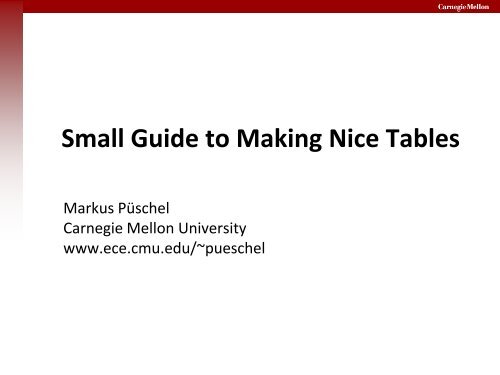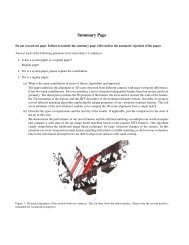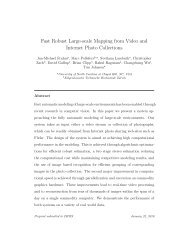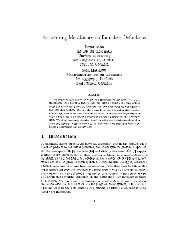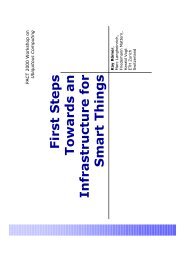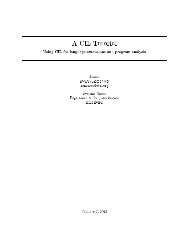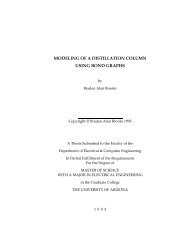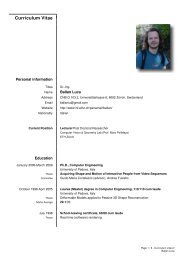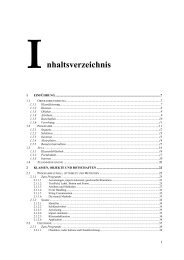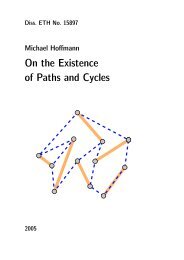Small Guide to Making Nice Tables
Small Guide to Making Nice Tables
Small Guide to Making Nice Tables
Create successful ePaper yourself
Turn your PDF publications into a flip-book with our unique Google optimized e-Paper software.
<strong>Small</strong> <strong>Guide</strong> <strong>to</strong> <strong>Making</strong> <strong>Nice</strong> <strong>Tables</strong><br />
Markus Püschel<br />
Carnegie Mellon University<br />
www.ece.cmu.edu/~pueschel
Which One Looks Better?<br />
Easy decision, isn’t it?
Another One<br />
If your tables tend <strong>to</strong> look like the above<br />
you may find this guide helpful
Background<br />
� Up <strong>to</strong> 2005, I had been writing technical publications for 8<br />
years, creating roughly 35 fully reviewed papers, 2 theses,<br />
20 proposals, and many other pages of technical writing<br />
� In each case I spent a lot of effort on content and visual<br />
presentation; I am really picky<br />
� In 2005 I learned (from Goran Frehse, thank you!) that I<br />
had had no clue how <strong>to</strong> make tables<br />
� I summarize what I have learned in this short guide
Resources<br />
� “Chicago Manual of Style,” The University of Chicago<br />
Press<br />
� Latex users: Use booktabs.sty and its documentation<br />
http://texcatalogue.sarovar.org/entries/booktabs.html
Most Important <strong>Guide</strong>lines for <strong>Making</strong> <strong>Tables</strong><br />
� Avoid vertical lines<br />
� Avoid “boxing up” cells, usually 3 horizontal lines are<br />
enough: above, below, and after heading (see examples in<br />
this guide)<br />
� Avoid double horizontal lines<br />
� Enough space between rows<br />
� If in doubt, align left
Example: Before and After<br />
Before:<br />
After:<br />
also the first column<br />
gets a header<br />
more space between rows<br />
everything left aligned<br />
three horizontal lines only,<br />
I like the <strong>to</strong>p and bot<strong>to</strong>m ones bolder<br />
space <strong>to</strong> the left edge removed space <strong>to</strong> the right edge removed
In Latex<br />
� Style: \usepackage{booktabs}<br />
� Horizontal lines: read documentation of booktabs<br />
http://texcatalogue.sarovar.org/entries/booktabs.html<br />
� More space between rows:<br />
\renewcommand{\arraystretch}{1.2} (or 1.3)<br />
� Remove space <strong>to</strong> the vertical edges:<br />
\begin{tabular}{@{}lll@{}} …
Hierarchical <strong>Tables</strong>: Examples<br />
One level of hierarchy:<br />
x-axis only<br />
One level of hierarchy:<br />
x-axis and y-axis
Latex Example<br />
Table from the bot<strong>to</strong>m of the previous slide:<br />
\usepackage{booktabs}<br />
\newcommand{\ra}[1]{\renewcommand{\arraystretch}{#1}}<br />
\begin{table*}\centering<br />
\ra{1.3}<br />
\begin{tabular}{@{}rrrrcrrrcrrr@{}}\<strong>to</strong>prule<br />
& \multicolumn{3}{c}{$w = 8$} & \phan<strong>to</strong>m{abc}& \multicolumn{3}{c}{$w = 16$} &<br />
\phan<strong>to</strong>m{abc} & \multicolumn{3}{c}{$w = 32$}\\<br />
\cmidrule{2-4} \cmidrule{6-8} \cmidrule{10-12}<br />
& $t=0$ & $t=1$ & $t=2$ && $t=0$ & $t=1$ & $t=2$ && $t=0$ & $t=1$ & $t=2$\\ \midrule<br />
$dir=1$\\<br />
$c$ & 0.0790 & 0.1692 & 0.2945 && 0.3670 & 0.7187 & 3.1815 && -1.0032 & -1.7104 & -21.7969\\<br />
$c$ & -0.8651& 50.0476& 5.9384&& -9.0714& 297.0923& 46.2143&& 4.3590& 34.5809& 76.9167\\<br />
$c$ & 124.2756& -50.9612& -14.2721&& 128.2265& -630.5455& -381.0930&& -121.0518& -137.1210& -220.2500\\<br />
$dir=0$\\<br />
$c$ & 0.0357& 1.2473& 0.2119&& 0.3593& -0.2755& 2.1764&& -1.2998& -3.8202& -1.2784\\<br />
$c$ & -17.9048& -37.1111& 8.8591&& -30.7381& -9.5952& -3.0000&& -11.1631& -5.7108& -15.6728\\<br />
$c$ & 105.5518& 232.1160& -94.7351&& 100.2497& 141.2778& -259.7326&& 52.5745& 10.1098& -140.2130\\<br />
\bot<strong>to</strong>mrule<br />
\end{tabular}<br />
\caption{Caption}<br />
\end{table*}
Further Examples<br />
� The following tables are taken from the magazine<br />
Economist<br />
� They demonstrate<br />
� How <strong>to</strong> handle multiple levels of hierarchy<br />
� Alignment, handling of long headers<br />
� The use of light gray <strong>to</strong> further divide the tables<br />
� Horizontal lines provide readability under denser packing and<br />
when lots of numbers are organized<br />
� Sans serif fonts are preferrable for readability;<br />
of course, if you need math symbols and use latex, then stick with<br />
roman<br />
� Title above table, sometimes with unit of measure<br />
� The use of footnotes<br />
� Different types of horizontal lines<br />
(I personally don’t like the use of more than two)
Example <strong>Tables</strong> I
Example <strong>Tables</strong> II
Example <strong>Tables</strong> III
Example <strong>Tables</strong> IV
Example <strong>Tables</strong> V


